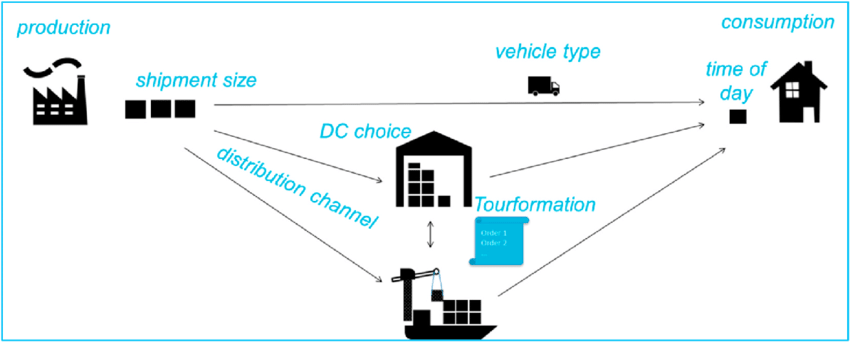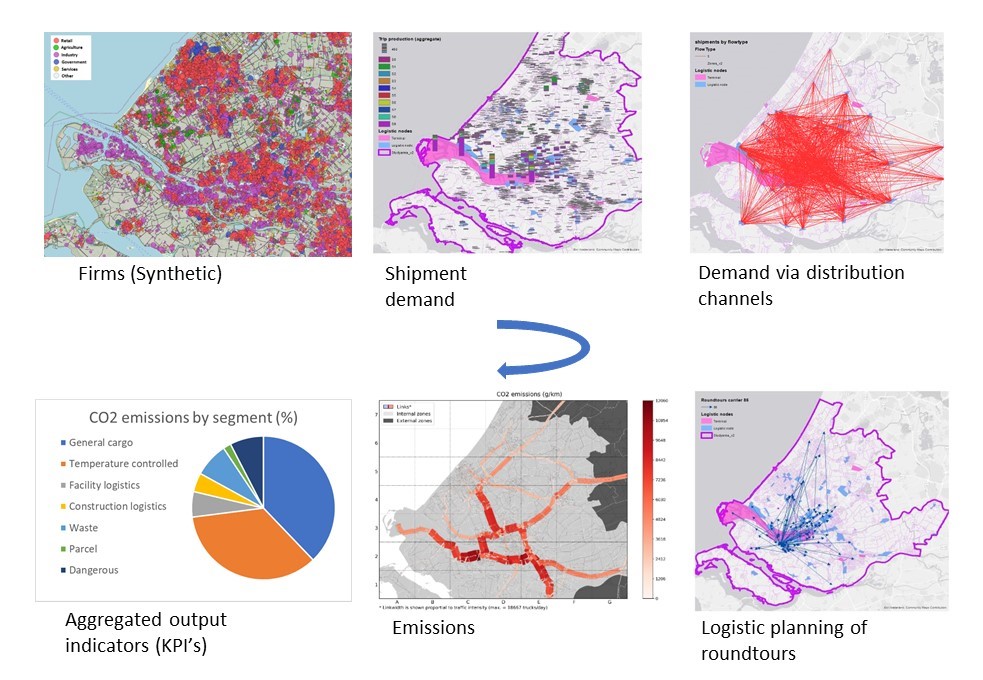Mass-GT
The MASS-GT project was started at TU Delft in 2017. Both Michiel de Bok and Lori Tavasszy ventured off on the quest to develop multi-agent simulation models for urban freight transport. Main motivators were the absence of strategic simulation tool for impact assessment of city logistic developments and policies, and the emergence of new sources of large data collections on freight transport.
The MASS-GT project was started at TU Delft in 2017. Both Michiel de Bok and Lori Tavasszy ventured off on the quest to develop multi-agent simulation models for urban freight transport. Main motivators were the absence of strategic simulation tool for impact assessment of city logistic developments and policies, and the emergence of new sources of large data collections on freight transport.
Conceptual model
The acronym MASS-GT stands for Multi-Agent Simulation System for Goods Transport and expresses the general specifications of the approach. First of all, the multi-agent approach is adopted to explicitly address the heterogeneity of stakeholders that are involved in urban freight transport (e.g. producers, customers, carriers, local administrators). Second, an extensive dense dataset with freight vehicle trip diary data is used to develop data-based simulation solutions and calibrate logistical choice models. Demand is simulated at the unit of shipments (instead of vehicles) to complement the more behavioural approach we are aiming at. Some shipments are transported directly from producer to consumer but many goods are transported via distribution channels with one or more ‘logistical nodes’. Therefore distribution centers and transshipment terminals are represented as logistic nodes, to distinguish transportation flows that are part of a multi-tier distribution channel. Figure 1 illustrates how the goods are transported as shipments between producer and consumer, and where which logistical choices are made. It illustrates strategic choices, such as distribution channel choice, shipment size, and tactical choices such as vehicle type and tour formation.
The evolutionary development of the approach is published in a number of publications, and is still further evolving. In several research projects different components, or improved release of the system are being developed. These incremental progression takes place in diverse parallel projects: a H2020 innovation projects, PhD projects, or MSc projects.
The next figure gives an indication of the scope of the simulation and (intermediate) results.
Mass-GT in HARMONY Project
The project HARMONY (http://harmony-h2020.eu/) has the objective to develop a new generation of harmonized spatial and multimodal transport planning tools which comprehensively model the dynamics of the changing transport and mobility sectors and impacts of new technologies and services. For the urban freight transport domain a Tactical Freight Simulator is being developed, and which is based on an previous versions of the multi-agent simulation system MASS-GT. In HARMONY the MASS-GT approach is further extended by improving the logistic decision models and implementing the use-cases addressed in the HARMONY project.
Approach
As explained, ‘the’ MASS-GT model, is developed in an evolutionary approach. This means different releases of the simulator have been developed, and many will follow.
Contributions are made from a diverse community or researchers. Michiel de Bok is main architect and coordinator behind the approach. Professor Lorant Tavasszy is the scientific chief behind the project. Ioanna Kourounioti is Post-doc Researcher in the HARMONY and LEAD projects and contributing to data collection and development of the logistic choice models. Raeed Mohammed is PhD student who is developing advanced logistic choice models. Individual MSc students have contributed to the exploration of relevant solutions for specific components: Sebastiaan Thoen (Tour formation), Ivar Bal (Vehicle type and shipment size choice), Maarten Berendschot (crowdshipping).
Through the H2020 projects different external partners are involved. Contributing to the simulator are: Significance (www.significance.nl), City of Rotterdam (https://www.rotterdam.nl/english/).
Open source
MASS-GT is developed in Python, adopting the open source philosophy. External users are invited to make use of existing subversions of the model, and to contribute to the further development of the simulation approach (GPL 2.0 license). For access see the following public GitHub page:
To get access to the code, contact Sebastiaan Thoen (thoen@significance.nl) or Michiel de Bok (m.a.debok@tudelft.nl).
Publications
de Bok, M, L Tavasszy, I Kourounioti, S Thoen, L Eggers, V Mayland Nielsen, J Streng (2021) Application of the HARMONY tactical freight simulator to a case study for zero emission zones in Rotterdam, Transportation Research Records, in press
Thoen, S, L Tavasszy, M de Bok, G Correia, R van Duin (2020) Descriptive modeling of freight tour formation: A shipment-based approach, Transportation Research Part E, Volume 140, Pages XX – XX (https://doi.org/10.1016/j.tre.2020.101989)
de Bok, M, I Bal, L Tavasszy, T Tillema (2020) Exploring the impacts of an emission based truck charge in the Netherlands, Case Studies on Transport Policy, Volume 8, Pages 887 – 894. (https://doi.org/10.1016/j.cstp.2020.05.013)
Thoen, S, M de Bok and L Tavasszy (2020) Shipment-based urban freight emission calculation. 2020 Forum on Integrated and Sustainable Transportation Systems (FISTS) in Delft. (DOI: 10.1109/FISTS46898.2020.9264858)
de Bok, M, L Tavasszy, S Thoen (2020) Application of an empirical multi-agent model for urban goods transport to analyze impacts of zero emission zones in The Netherlands, Transport Policy, Volume XX, Pages XX – XX. (in press). (https://doi.org/10.1016/j.tranpol.2020.07.010)
de Bok, M, L Tavasszy (2018) "An empirical agent-based simulation system for urban goods transport (MASS-GT)." Procedia Computer Science, 130: 8. (https://doi.org/10.1016/j.procs.2018.04.021)


